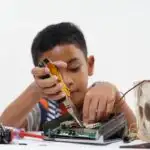When navigating the educational landscape with a dyslexic child, you can come up against a lot of different and unique challenges that aren’t present for kids who don’t have any additional needs.
In this guide, we will acknowledge the specific needs of dyslexic learners, fostering an environment where their abilities can shine.
We understand the importance of tailoring educational approaches to the individual, recognizing that traditional methods may not always align with the strengths of dyslexic minds.

Throughout this article, we’ll take a look at some great practices and proven techniques that can cater to diverse learning styles, empowering both you and your child.
From decoding language barriers to cultivating a supportive learning environment, we’ll guide you through each step.
So, grab yourself a cup of something caffeinated, and let’s get learning.
Understanding Dyslexia
Understanding dyslexia is pivotal to providing effective support for your child’s educational journey.
Dyslexia is a neurological condition that affects the acquisition of reading, spelling, and writing skills.
It stems from differences in the way the brain processes information related to language, leading to challenges in decoding and recognizing words.
This impact on learning, however, is highly individualized, with dyslexia manifesting diversely from person to person.
In each case, dyslexic individuals may encounter difficulties in phonological processing, rapid naming, and working memory, which are essential components of proficient reading.
This diversity underscores the importance of recognizing and addressing the unique strengths and challenges of your child.
By acknowledging the individual nature of dyslexia, we can tailor educational approaches to maximize learning potential and empower your child to navigate the academic landscape with confidence and competence.
Early Identification And Assessment
Recognizing signs of dyslexia early on is fundamental to tailoring effective homeschooling strategies. You, as a parent, play a crucial role in identifying these indicators.
Keep an attentive eye on your child’s language development, observing potential challenges in phonological awareness, word recognition, and spelling.
If you notice persistent difficulties, consider seeking professional assessments.
Homeschooling allows for a personalized approach to assessment, enabling you to adapt methods based on your child’s specific needs.
Engage in open communication with your child, their educators, and educational specialists to collaboratively develop strategies that address any identified challenges.
Tailoring The Learning Environment
Crafting an ideal home learning space for your child with dyslexia is a pivotal aspect of homeschooling success. Begin by minimizing distractions – create a quiet area conducive to focused learning.
Ensure good lighting and comfortable seating to optimize concentration. You should also try to foster a positive atmosphere by celebrating small victories, reinforcing a growth mindset, and encouraging open communication.
Tailoring the learning environment involves understanding your child’s preferences and adapting methods accordingly.
By personalizing the space and incorporating multisensory environments into lessons (something we’ll go over later), you can create an environment where your child can thrive academically, building confidence and a love for learning within the comforts of home.
Adapting Teaching Methods
In tailoring your educational approach for dyslexic learners, adapting teaching methods becomes paramount.
Embrace evidence-based strategies such as structured literacy programs that focus on phonics, decoding, and encoding skills.
You should try to integrate multisensory techniques that incorporate visual, auditory, and kinesthetic elements to reinforce learning.
By breaking tasks up into manageable steps and providing ample time for practice, you can personalize your instructions and offer constructive, actionable feedback.
Additionally, keep track of your child’s diverse learning styles and make use of audiobooks, interactive software, and hands-on activities if these are more accessible to your child.
By customizing your teaching approach to align with the strengths of dyslexic learners, you create an inclusive and effective educational experience that maximizes their academic potential.
Multisensory Learning Approaches
We’ve mentioned multisensory learning approaches a few times, but what exactly do we mean by this? Let’s look into it.
A multisensory learning approach offers your child a variety of ways to engage in their learning material, often a lot more tactile and auditory.
This approach engages various senses simultaneously, reinforcing connections in the brain.
For instance, incorporating tactile elements like letter cards for touch, phonics games for auditory stimulation, and interactive reading exercises for visual engagement.
Cooking or crafting activities can integrate hands-on experiences, enhancing comprehension.
By intertwining auditory, visual, and tactile stimuli, you cater to diverse learning styles, making lessons more accessible and enjoyable.
Embracing these techniques not only reinforces academic concepts but also fosters a dynamic and inclusive learning environment, allowing your child to grasp and retain information more effectively.

Assistive Technologies And Resources
Empowering your child with dyslexia involves leveraging assistive technologies tailored to their needs. Consider text-to-speech software, which reads text aloud, which aids comprehension.
Dyslexic-friendly fonts and e-books with adjustable backgrounds enhance reading experiences.
You can explore speech recognition tools for writing assignments. Educational apps designed to reinforce phonics and spelling offer interactive learning.
Additionally, you can look at audiobooks, which enable your child to absorb information auditorily, meaning that they’re not always required to work so hard to enjoy literature.
Accessible learning resources like online dyslexia communities, specialized tutoring services, and dyslexia-friendly publications further enrich your homeschooling toolkit.
Embracing these assistive technologies and resources ensures a supportive educational environment.
Building Confidence And Self-Esteem
Understanding the emotional impact of dyslexia is crucial for nurturing a child’s confidence. You need to be able to recognize their unique strengths and accomplishments to foster self-esteem.
This could be by celebrating small victories like mastering a new word or completing a reading assignment.
Create a positive learning atmosphere by emphasizing the importance of effort over perfection.
Encourage open communication, allowing your child to freely express frustrations and triumphs without judgment, creating a safe space for growth.
By integrating activities that align with your child’s interests and learning styles, you can instill a positive attitude towards learning rather than fueling their anxiety and resentment towards education.
Remember, building confidence is an ongoing process, and with patience and support, your child can thrive academically and emotionally.
Collaboration And Support
In our pursuit of nurturing a conducive learning environment for dyslexic learners, collaboration and support stand as crucial pillars.
Engaging with educators and specialists ensures a comprehensive understanding of your child’s unique needs.
Regular communication with teachers facilitates the implementation of tailored strategies, promoting a more inclusive approach to education.
Additionally, you should try tapping into the support networks available to you.
By connecting with other homeschooling parents of dyslexic children, you can create a wealth of shared experiences and practical advice.
Online forums, local support groups, and social media communities are excellent platforms for building these connections.
Together, you can exchange insights, troubleshoot challenges, and celebrate victories, fostering a collective knowledge base that strengthens your homeschooling endeavors.
Tracking Progress
Ensuring your child’s educational journey remains effective involves continuous tracking of progress and a flexible approach to teaching.
Regular assessments tailored to your child’s learning style provide valuable insights into their development.
Celebrate achievements, both big and small, to boost confidence and motivation. If challenges arise, consider adjusting specific difficulties with targeted interventions.
Stay attuned to your child’s feedback and observe their engagement with different learning materials.
This ongoing evaluation allows you to refine your strategies, ensuring a dynamic and responsive homeschooling environment.
By focusing on adaptability and personalized progress monitoring, you empower both you and your child to navigate the educational landscape successfully.
Final Thoughts
A tailored and understanding approach is the cornerstone of success.
By embracing the unique needs of your child and implementing evidence-based strategies, you’ve laid a foundation for a fulfilling educational experience.
Remember, the path may have its challenges, but with perseverance and the right tools, your child can thrive personally and academically.
As we conclude, it’s crucial to appreciate the progress made and acknowledge that education is an evolving process.
Celebrate the small victories, whether it’s improved reading skills, increased self-confidence, or a newfound love for learning. Recognize that the journey is ongoing, and flexibility is key.
It’s important to stay informed about new developments in dyslexia education and be open to adjusting your approach as your child’s needs evolve.
You’re not alone in this educational venture. Reach out to support networks, connect with other parents facing similar challenges, and continue to collaborate with educators and specialists.
Armed with knowledge and a commitment to your child’s well-being, you’ve set the stage for a future where their potential knows no bounds.
Here’s to the continued growth and success of your dyslexic learner. Happy learning!
Frequently Asked Questions
How does homeschooling benefit dyslexic children?
Homeschooling provides a personalized learning environment, allowing tailored strategies and pacing that suit dyslexic learners, fostering confidence and academic success.
What teaching methods work best for dyslexic homeschooling?
Multisensory approaches, such as Orton-Gillingham, and adaptive technologies prove effective. Customize materials to accommodate diverse learning styles for optimal results.
How can I track my dyslexic child’s progress in homeschooling?
Regular assessments, ongoing observation, and keeping a portfolio of achievements help track progress. Adjust teaching methods based on individual needs as you observe growth.
- Homeschooling In High School: Pros And Cons - February 24, 2024
- How Do I Withdraw My Child From School To Homeschool? - February 23, 2024
- How To Not Go Crazy Homeschooling Kids: A Guide For Frazzled Parents - February 22, 2024









Leave a comment